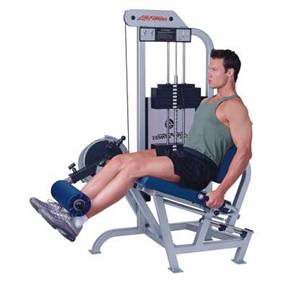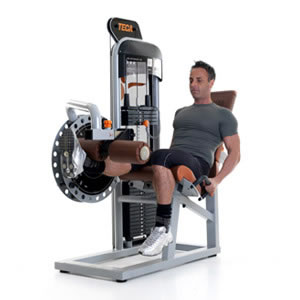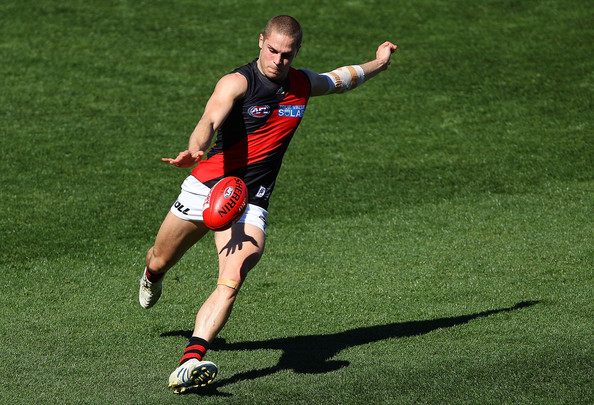Leg extensions to improve kicking? Not exactly
I recently had a conversation with a young footy player (19) about the strength training he was doing. And one of the things that he told me about was all the leg extensions he had been doing in order to improve his kicking. This gave me the inspiration for this article, as it ties in with another article on specificity – and I thought that this discussion on leg extensions and kicking would be a good example of some of the points that I was trying to make in the previous article.
Just a quick note - the leg extensions we are talking about here those that are performed seated in a machine.
So this young lad was telling me about the leg extensions that he has been doing, and he pointed out that because he is trying to improve his kicking, he has been doing them mainly single legged, rather than the standard double legged variety. This was a positive sign, as it showed that he had been considering making this exercise more specific to his goal (kicking further), so at least I could see that he had been thinking about what he is doing. However, as I will explain, this use of the leg extension machine is still misguided for this goal.
Referring back to a previous article, we mentioned biomechanical specificity – in which an exercise physically mimics the basic mechanics of the movement for which you are training. At first glance, a single legged leg extension would appear to be pretty similar to a kicking motion in footy. After all it requires that you flex your quad muscles and extend your leg out, just as in a standard kick. However, this is where the similarity ends. Consider these points;
- You are seated when you do a leg extension, when you kick, you are standing.
- When seated in a leg extension, you are also holding onto handles to hold yourself in place.
- This seated leg extension is an isolation exercise, where you only use your quads and nothing else. When you kick a ball, you will enact a complicated full body coordinated movement – and every muscle is vital to the execution of the kick. Even if we focus purely on the lower body only, on the leg that is kicking the ball, you will also have a strong contribution from your adductors as well as require the eccentric strength and coordination of the hamstrings to counter balance the explosive power of the quads in the kicking motion, at the end of the movement. The non kicking leg is required to perform balance and a stable platform to launch the kick from, which requires a great deal of isometric (static/still) strength and coordination from all the muscles within this leg (we wont list them all.) Not to mention the vital work being performed by your hip stabilisers in order to launch the kick effectively (if they aren’t doing their job, your knees and/or lower back will soon find out about it.) And this is just the lower body – we haven’t yet even touched on the work from the core and oblique muscles (as there is a large rotation component involved in kicking.)
So you can see that biomechanically, a seated leg extension is absolutely nothing like a kick in footy after all. As a result, biomechanical specificity can no longer be used as a reason to do a leg extension.


Neither of these are anything like a kick
Another point we covered about specificity in the earlier mentioned article was kinetic or kinematic specificity – or more specifically the speed of movement and rate of force development. In other words, the more closely a training exercise mimics the speed of movement of a task that you are training for, the more specific it is, and therefore the higher the level of carryover. Generally speaking, when you see someone performing a leg extension, the speed of movement is only a moderate speed at best, as the person performing it looks to move a heavy load to build this muscle. If you look at a kick, it is executed in a fraction of a second (the extension component anyway.) This would mean that in performing a seated leg extension, you are training slow in order to improve a skill/task that is performed explosively quick.
 Look at the picture closely, and hopefully you can visualise just how different the work of the quadriceps are here (as well as the hips stabilisers, glutes and hamstrings) to a seated leg extesntion
Look at the picture closely, and hopefully you can visualise just how different the work of the quadriceps are here (as well as the hips stabilisers, glutes and hamstrings) to a seated leg extesntion
S
o leg extensions are not specific for footy, as the carryover is extremely low, for the reasons mentioned above. Combined with the fact that they aren’t a good functional general exercise (like squat, lunge, deadlift, step up, etc, are), there is little reason to do them if you are aiming at improving your kicking distance.
But what of improving kicking distance? How?
What strength exercises will improve my kick? In short, there is no specific strength exercise that is particularly specific to improving kicking distance, purely because it is such a technical and highly complex task, involving the coordination of just about every muscle in the body – not just the legs, as many people tend to think. But there are particular principles to follow that will steer you in the right direction.
Generally speaking, exercises that allow you to develop maximal strength in the legs including both double legged exercises (like squats and deadlifts) and then also single legged exercises (lunges, step ups, single leg deadlifts, etc) will build the potential for increased distance via increasing the recruitment of muscle fibers, and therefore training your system to increase the number of fibers that it has the ability to recruit in other tasks (hence an increase in strength.) Then plyometric exercises will add the all-important speed component, in order to train these muscles and muscle fibers to be recruited maximally more rapidly – as remember kicking is a rapid movement.
So functional strength training exercises to increase maximal recruitment + functional plyometric exercises to increase the speed or rate of firing = increased potential to improve your kicking distance. However due to the technical nature of kicking, all strength and plyometric/power exercises will only be general in nature when it comes to improving kicking. Some exercises will be better than others (a split squat is infinitely better than a leg press), but even the best ones will only lay the foundation of potential for improved kicking distance. The all-important step to combine with this functional strength and power training, is actual kicking training itself. Practicing technique, coordination, speed of leg movement in the kick, powerful arm swing, etc, are examples of the specific nature of kicking training that you must focus on. Long and effective kicking isn’t about having the biggest or even the strongest leg muscles. Sure stronger leg muscles give you more potential, however coordination and speed of movement are vital elements that go into it. So if I was to give a brief outline of how to train to improve your kicking distance from a strength training point of view; focus on the functional maximal strength exercises that we have mentioned both is this article, in the books and the other articles, and combine these with powerful lower body plyometric work. But most importantly of all – practice your kicking technique/coordination/power as well as performing the strength and power work. Kicking is far too complex to improve simply by lifting weights.
Strength Coach

